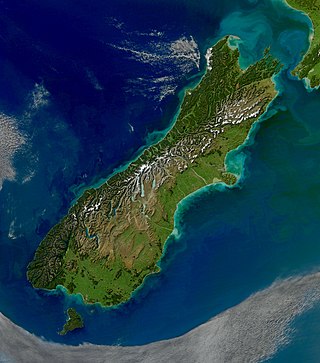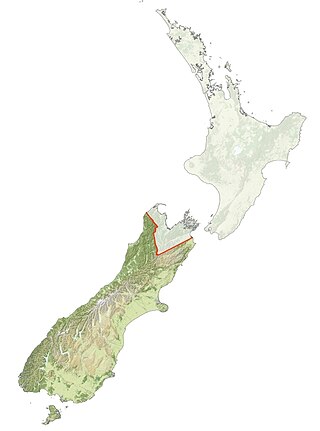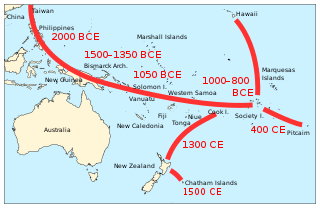
The South Island, also named Te Waipounamu in Māori, is the larger of the two major islands of New Zealand in surface area, the other being the smaller but more populous North Island. It is bordered to the north by Cook Strait, to the west by the Tasman Sea, and to the south and east by the Pacific Ocean. The South Island covers 150,437 square kilometres (58,084 sq mi), making it the world's 12th-largest island, constituting 56% of New Zealand's land area. At low altitude, it has an oceanic climate.

Lake Wānaka is New Zealand's fourth-largest lake and the seat of the town of Wānaka in the Otago region. The lake is 278 meters above sea level, covers 192 km2 (74 sq mi), and is more than 300 m (980 ft) deep.

The Otago Peninsula is a long, hilly indented finger of land that forms the easternmost part of Dunedin, New Zealand. Volcanic in origin, it forms one wall of the eroded valley that now forms Otago Harbour. The peninsula lies south-east of Otago Harbour and runs parallel to the mainland for 20 km, with a maximum width of 9 km. It is joined to the mainland at the south-west end by a narrow isthmus about 1.5 km wide.

Ngāi Tahu, or Kāi Tahu, is the principal Māori iwi (tribe) of the South Island. Its takiwā is the largest in New Zealand, and extends from the White Bluffs / Te Parinui o Whiti, Mount Mahanga and Kahurangi Point in the north to Stewart Island / Rakiura in the south. The takiwā comprises 18 rūnanga corresponding to traditional settlements. According to the 2018 census an estimated 74,082 people affiliated with the Kāi Tahu iwi.

Dunedin is the second-largest city in the South Island of New Zealand, and the principal city of the Otago region. Its name comes from Dùn Èideann, the Scottish Gaelic name for Edinburgh, the capital of Scotland. The city has a rich Māori, Scottish, and Chinese heritage.

The Polynesian Triangle is a region of the Pacific Ocean with three island groups at its corners: The US state of Hawaii, Easter Island and New Zealand (Aotearoa). This is often used as a simple way to define Polynesia.

Otakou is a settlement within the boundaries of the city of Dunedin, New Zealand. It is located 25 kilometres from the city centre at the eastern end of Otago Peninsula, close to the entrance of Otago Harbour. Though a small fishing village, Otakou is important in the history of Otago for several reasons. The settlement is the modern centre and traditional home of the Ōtākou rūnanga (assembly) of Ngāi Tahu. In 1946 Otakou Fisheries was founded in the township; this was later to become a major part of the Otago fishing industry.

Lake Hāwea is New Zealand's ninth largest lake.

The town of Palmerston, in New Zealand's South Island, lies 50 kilometres to the north of the city of Dunedin. It is the largest town in the Waihemo Ward of the Waitaki District, with a population of 890 residents. Palmerston grew at a major road junction: State Highway 1 links Dunedin and Waikouaiti to the south with Oamaru and Christchurch to the north, while State Highway 85 heads inland to become the principal highway of the Maniototo. The Main South Line railway passes through the town and the Seasider tourist train travels from Dunedin to Palmerston and back once or twice a week. From 1880 until 1989, the town acted as the junction between the main line and a branch line that ran inland, the Dunback and Makareao Branches.
Long Beach, known in Māori as Wharauwerawera or Wharewerawera is a small coastal settlement in Otago, New Zealand comprising approximately 100 homes. Many of the sections were initially auctioned in October 1922 for a pound deposit. It is located within the city limits of Dunedin, and lies 15 kilometres northeast of the city centre, between Blueskin Bay and the mouth of the Otago Harbour. The small settlement of Pūrākaunui is located nearby.
The Otago region of New Zealand is one of the more isolated places of the inhabited earth. Its high latitude, elevation and distance from larger foreign and domestic population centres have defined Otago at each stage of its history.
Uruaokapuarangi was one of the great ocean-going, voyaging canoes that was used in the migrations that settled the South Island according to Māori tradition.

Since the early 1900s the fact that Polynesians were the first ethnic group to settle in New Zealand has been accepted by archaeologists and anthropologists. Before that time and until the 1920s, however, a small group of prominent anthropologists proposed that the Moriori people of the Chatham Islands represented a pre-Māori group of people from Melanesia, who once lived across all of New Zealand and were replaced by the Māori. While this claim was soon disproven by academics, it was widely and controversially incorporated into school textbooks during the 20th century, most notably in the School Journal. This theory subsequently spawned modern claims of a pre-Māori settlement of New Zealand by various ethnic groups, many conspiratorial in nature. Today, such theories are considered to be pseudohistorical and negationist by scholars and historians, and racist by many observers, with the Moriori myth having been used to justify settler colonalism.
Whare Marama Leonard-Higgins (1928–2012) was an elder in the Ngāi Tahu iwi of the South Island of New Zealand.
Ulva Lynn Belsham was a telegraphist and volunteer radio operator for the Marine Radio Service in the southern part of the South Island of New Zealand.

Sarah Mary Catherine Stirling, known as Hera Stirling and, after her marriage, as Hera Munro, was a New Zealand Māori activist, suffragist, and missionary of Ngāi Tahu descent.
Whareakeake is a beach 25 kilometres (16 mi) northeast of Dunedin in the South Island of New Zealand, as well as the valley above and behind the beach. Located to the west of Aramoana and included as a section of the Otago Heads, Whareakeake was a place of habitation for Māori people from early times until the Sealers' War skirmish of 1817 from which it derived its colonial name. It is now a surfing beach renowned for its right-hand point break.

Aroha Gaylene Harris is a Māori academic. As of 2020, Harris is an associate professor at the University of Auckland, specialising in Māori histories of policy and community development. She is also a member of the Waitangi Tribunal.

Janet Mary Wilmshurst is a New Zealand palaeoecologist who works on reconstructing the ecological past. Wilmshurst has been a Fellow of the Royal Society Te Apārangi since 2015. She was president of the New Zealand Ecological Society, and currently works as principal scientist in long-term ecology at Manaaki Whenua Landcare Research focusing on recent fossil records to reconstruct and trace past ecosystem changes in response to natural disturbance.
Louise Mary Potiki Bryant is a New Zealand choreographer, dancer and video artist. She has choreographed a number of award-winning performances, and is a founding member of Atamira Dance Company. She designs, produces and edits videos of performances for music videos, dance films and video art installations. She was made an Arts Foundation of New Zealand Laureate in 2019.













